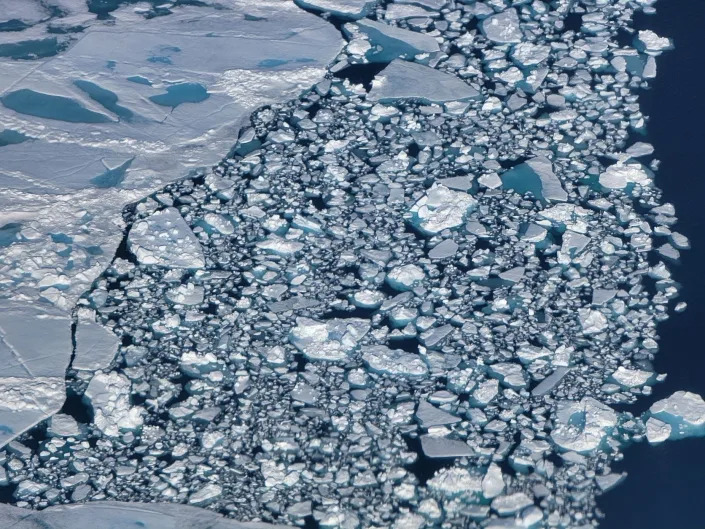USA Today
Greenland hit with ‘unusually extensive’ melting of ice sheet, boosting sea levels, scientists say
Saleen Martin – July 24, 2022


It’s getting hotter in Greenland, and last weekend temperatures rose enough to cause 18 billion tons of the country’s ice sheet to melt over three days.
Scientists have warned about the fate of Greenland’s ice sheet and say what happened between July 15 and 17 is the latest massive melting event contributing to an increase in the global sea level.
The amount of water from the melt – about 6 billion tons a day, or 18 billion tons over the weekend – is enough to “cover West Virginia in a foot of water – 4 inches per day, roughly,” Ted Scambos, a senior research scientist at the University of Colorado’s Earth Science and Observation Center and National Snow and Ice Data Center, told USA TODAY.
Video: Sightseers capture huge chunk of Norway glacier crumbling into sea
Sightseers capture huge chunk of Norway glacier crumbling into sea
During a tour in Spitsbergen, Norway, sightseers captured a portion of the Monaco glacier breaking off and crumbling into the sea.
Much of the melting came from northern Greenland because warm air drifted over from the Canadian Arctic Archipelago, Scambos said.
There is also a high-pressure dome over Greenland. Together, they created an “unusually extensive melt event,” he said.

Temps heating up in Greenland
Temperatures vary over Greenland, but the coldest temperatures are in areas of high elevation, toward the center of the ice sheet, said William Lipscomb, a senior scientist in the National Center for Atmospheric Research’s Climate and Global Dynamics Laboratory.
Once temperatures are above freezing or 32 degrees Fahrenheit, the melting begins. Temperatures last weekend were around 60 degrees, or 10 degrees warmer than normal for this time of year, according to CNN.
“In recent years, we’ve seen a lot of heat waves in Greenland, this recent warming of it being one example,” Lipscomb told USA TODAY. “Any temperature above freezing can cause some surface melting.”
More from Greenland: Greenland’s ice sheet is melting so fast, it’s raising sea levels and creating global flood risk
Fact check: Greenland is still losing ice; no reversal in trend
Greenland loses ‘tremendous amount of ice every year now’
In the 1980s and 1990s in Greenland, a melt event of this sort never occurred, but starting in the 2000s – especially since 2010 – the melting has been more extensive.
The melt is two times larger than normal, said Xavier Fettweis of the University of Liège. Fettweis, a polar researcher, created a model scientists use, along with satellite data, to study Greenland’s changes.
The melt is among two of the largest melts in the ice sheet history after the 2012 and 2019 melting events; in 2019, the runoff was about 527 billion tons. So far, the total melt is far below 2019 levels, but the situation is more dire over the Svalbard ice caps at the North of Norway, Fettweis said.
More melting was expected, said Scambos, of the National Snow and Ice Data Center. “This event is one of many events over the whole summer,” he said. “We can expect on the order of 100 billion tons of water going into the ocean. Greenland as a whole is losing a tremendous amount of ice every year now.”

NASA Goddard Space Flight Center ice scientist Nathan Kurtz was recently in Greenland to help better calibrate ICESat-2, one of the agency’s satellites used to monitor Greenland.
Its data has shown a loss of ice from Greenland of about 200 billion tons a year over the past two decades, Kurtz told USA TODAY. “This loss of ice contributes directly to global sea level rise, which has significant societal impacts,” he said.
Lipscomb, of the National Center for Atmospheric Research, said scientists measure the amount of water melted in units of gigatons per year, or 1 billion tons of water. Before climate change, about 600 gigatons of snowfall were coming in each year and about 300 gigatons were going out in the form of summer melting.
Now, Greenland’s ice sheet is losing nearly 300 gigatons of water each year more than it gains from snowfall, Lipscomb said. “There’s still time to avoid catastrophic sea level rise, but every year that greenhouse gas emissions continue at the present rate increases the chances of serious problems down the road.”
In some parts of the world such as Asia, seasonal water supply depend on the timing of the glacier melt.
“If the melt is happening too early, you may not be getting the water when you need it for farming,” he said. “And if the glaciers completely melt, then you won’t have the glacier melt water source at all. And that’s something people worry about for later this century as the warming continues.”
Saleen Martin is a reporter on USA TODAY’s NOW team. She is from Norfolk, Virginia – the 757 – and loves all things horror, witches, Christmas, and food.
